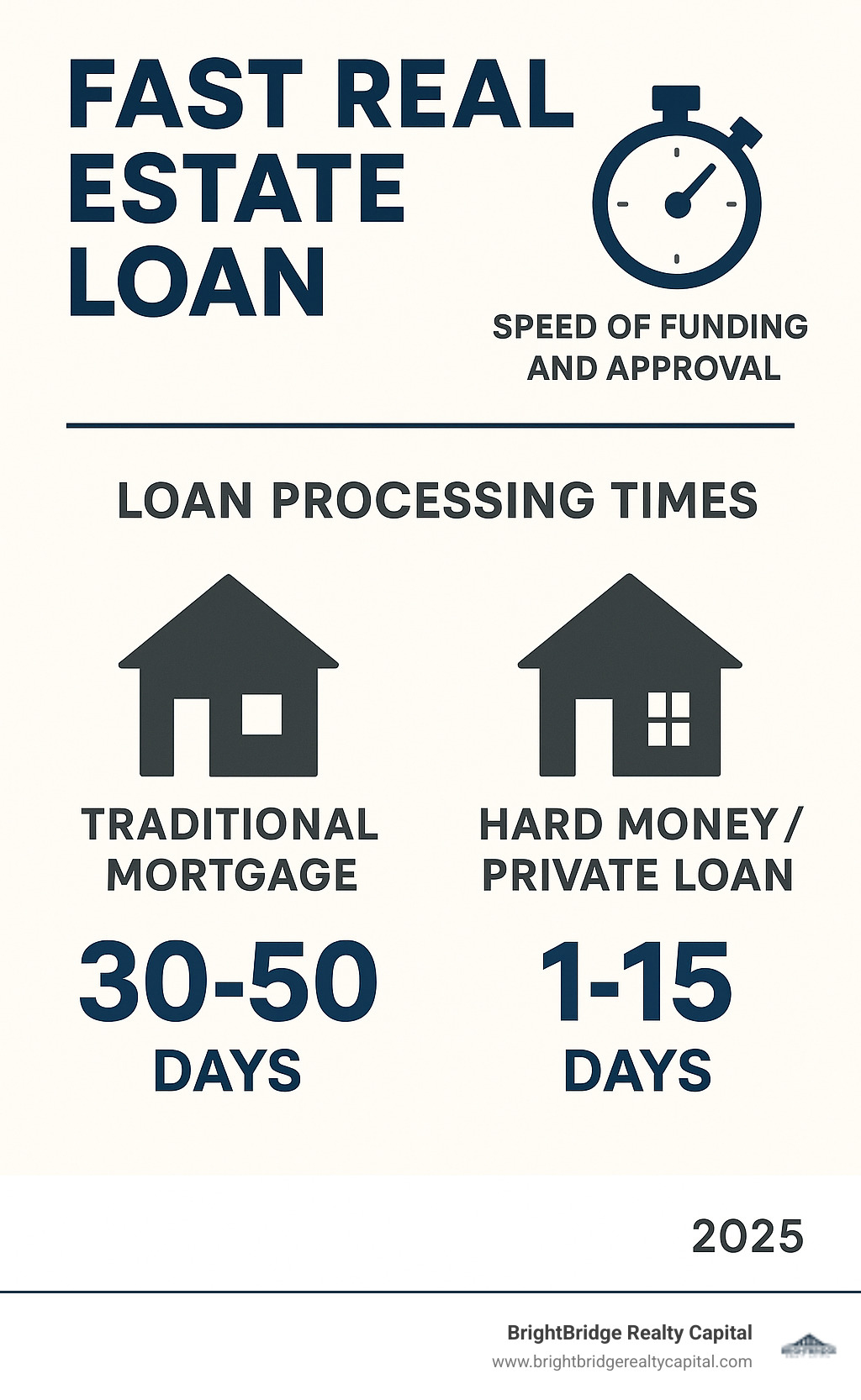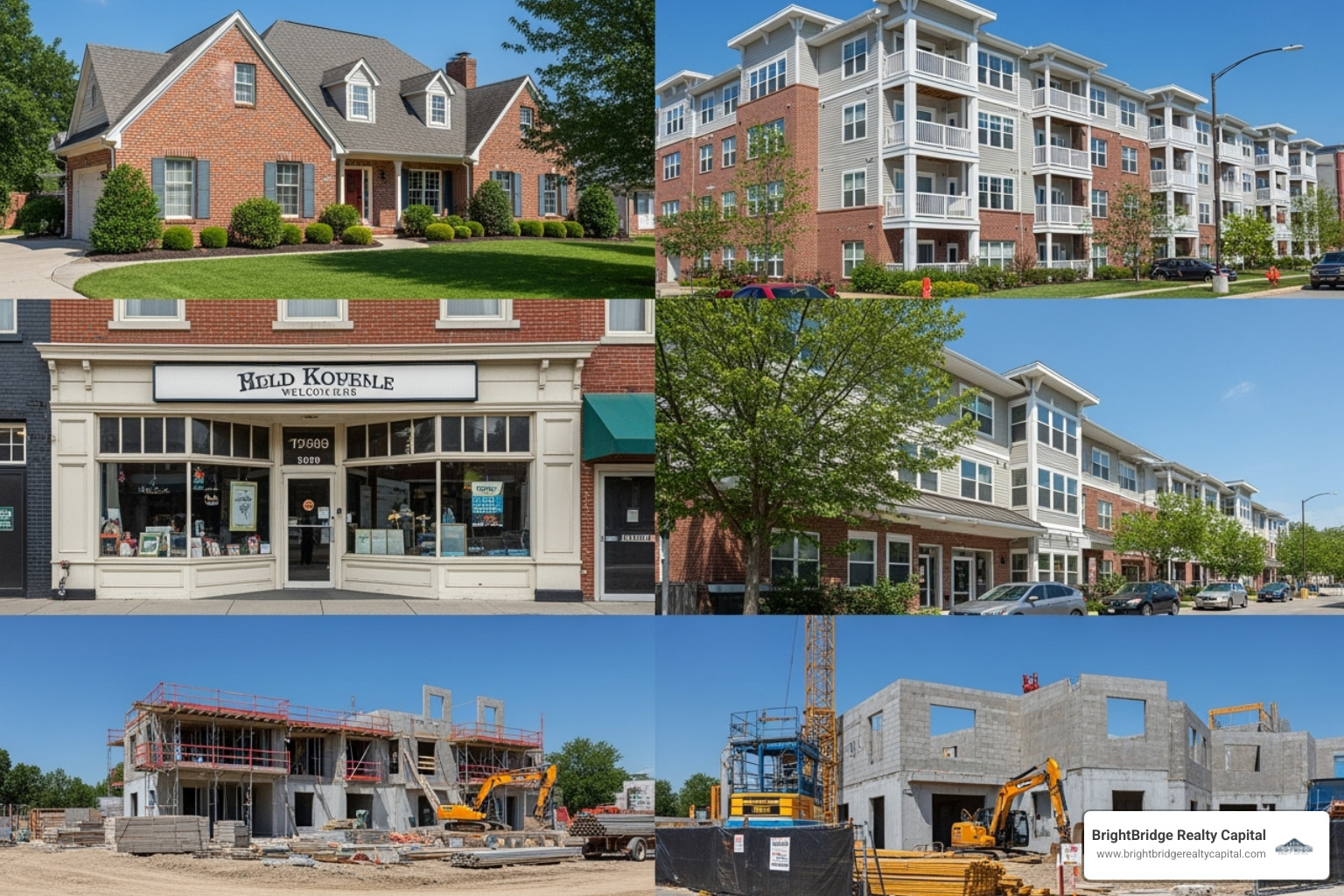Accelerate Your Deals: Finding the Right Fast Real Estate Loan for You

Navigating the World of Fast Real Estate Loans
Imagine this scenario: you're a real estate investor who has just found the perfect distressed property. It's undervalued, in a great neighborhood, and has incredible potential. The seller, facing financial pressure, needs to close the deal in ten days. You know that with a few strategic renovations, you can flip it for a significant profit. You approach your bank for a mortgage, but they quote you a 45-day closing timeline, bogged down by endless paperwork and rigid underwriting. By the time they might approve your loan, the opportunity will be long gone, snapped up by a cash buyer. This is a common frustration for investors, and it highlights a critical truth in the property market: speed is currency. A fast real estate loan is the financial tool designed to solve this exact problem, providing rapid funding for property deals that simply can't wait.
These specialized loans, also known as hard money or bridge loans, can close in as little as 1-15 business days, a stark contrast to the 30-50 days typical of traditional bank loans. This velocity is their defining feature and their most powerful advantage. Key benefits that stem from this speed include:
- Rapid Approval and Funding: Receive a loan commitment in 1-5 business days and funding shortly after.
- Asset-Based Underwriting: Lenders prioritize the property’s intrinsic value and potential over the borrower's personal credit history or income documentation.
- Reduced Administrative Burden: Experience a streamlined application process with significantly less paperwork and fewer bureaucratic problems than conventional lenders.
In a competitive real estate landscape, the ability to act decisively is not just an advantage; it's often the deciding factor between securing a lucrative deal and watching it slip away. As one industry expert noted, "Speed to close is one of the most important components of a successful real estate investing business." This comprehensive guide will dig deep into fast real estate loans, showing you how to leverage them effectively to achieve your investment goals.
I'm Daniel Lopez, a senior loan officer at BrightBridge Realty Capital. With over a decade of experience in alternative financing, I specialize in helping investors across the nation secure the right fast real estate loan for time-sensitive opportunities. My role is to explain complex financing structures, enabling our clients to steer the process with clarity and close their deals with unwavering confidence. This guide will equip you with the knowledge to understand what these loans are, who they are for, how to qualify, and how to strategically deploy them for maximum profit.

Handy fast real estate loan terms:
What Are Fast Real Estate Loans and How Do They Differ from Traditional Mortgages?
When we talk about a fast real estate loan, we're referring to a category of specialized financing instruments where speed, flexibility, and asset value are the paramount considerations. These loans are secured by real property and are typically provided by private companies, investment funds, or groups of individuals—not large, federally chartered banks. They are not just a last resort but a strategic tool used by savvy investors when conventional financing is too slow, too restrictive, or simply unavailable for a particular type of project.

The fundamental difference between a fast real estate loan and a traditional mortgage lies in the underwriting philosophy. A traditional lender, like a bank or credit union, is primarily focused on you, the borrower. Their underwriting process is a deep dive into your personal financial life: your credit score, your employment history, your income stability, and your debt-to-income (DTI) ratio. They want to see years of tax returns, pay stubs, and bank statements to verify that you are a low-risk borrower with a proven ability to repay debt over a long period.
A fast real estate loan lender takes a different path. Their primary focus is on the value, equity, and marketability of the property itself. This approach is known as asset-based lending. The core question for the lender is not "Can the borrower afford this based on their income?" but rather "Is this a good deal with enough protective equity in the property to secure our investment?" The property is the primary source of security. Because this approach accepts risks that banks will not (e.g., imperfect credit, unseasoned income, properties needing renovation), these loans carry higher interest rates and fees—the necessary trade-off for unparalleled speed and flexibility.
The Need for Speed: Why Timing is Everything
In real estate, opportunities are fleeting. A small delay in securing financing can mean missing out on a career-defining deal. This is especially true in several key scenarios:
- Competitive Seller's Markets: When multiple buyers are bidding on a property, an offer that can close in 10 days is often perceived as stronger than a slightly higher offer contingent on a 45-day financing period. Sellers prioritize certainty and speed.
- Real Estate Auctions: Auctions, whether for foreclosures or other properties, require buyers to close within a very short timeframe (often 10-30 days). Traditional financing is simply not an option. A fast loan allows an investor to bid with the confidence of a cash buyer.
- Distressed Properties: Banks are often hesitant to lend on properties that are in disrepair. Fast loan lenders, however, specialize in these scenarios, often lending based on the After Repair Value (ARV), providing funds for both the purchase and the renovation.
- Time-of-the-Essence Contracts: Some purchase agreements include a "time is of the essence" clause, making the closing date a legally binding deadline. A fast loan ensures you can meet this obligation and avoid legal complications or losing your deposit.
In-Depth Comparison: Traditional Mortgages vs. Fast Loans
This table illustrates the key differences, followed by a detailed explanation of each point:
| Feature | Traditional Mortgage | Fast Real Estate Loan |
|---|---|---|
| Speed | Approval: Weeks; Funding: 30-50 days | Approval: 1-5 days; Funding: 7-15 days (can be 1 day) |
| Criteria Focus | Borrower's credit, income, DTI, employment history | Property's equity (LTV), marketability, exit strategy |
| LTV Ratio | Up to 80-95% of purchase price | Typically 65-75% of current value or ARV (some up to 90% of purchase) |
| Interest Rates | Generally lower (e.g., 6.95-10.5%) | Significantly higher (e.g., 8-18%) |
| Fees | Lower origination fees (0.5-1%) | Higher origination fees/points (1-5%) |
| Documentation | Extensive (tax returns, bank statements, pay stubs) | Minimal (property details, exit strategy, basic borrower info) |
| Underwriting | Rigid, rule-based, automated systems | Flexible, 'make sense' underwriting, case-by-case analysis |
| Loan Term | Long-term (15-30 years), amortizing | Short-term (6-18 months), often interest-only |
| Lender Type | Banks, credit unions, large mortgage companies | Private lenders, hard money funds, investment groups |
| Prepayment Penalty | Rare on conforming loans | Common, often structured as a minimum interest guarantee |
Detailed Breakdown of Differences:
- Speed & Criteria Focus: As discussed, this is the primary distinction. Banks use a borrower-centric model that requires extensive verification, slowing the process. Fast lenders use a property-centric model, allowing for quicker decisions based on the asset's quality.
- Loan-to-Value (LTV) Ratio: Traditional loans may offer a higher LTV on the purchase price for a qualified borrower. Fast loans are more conservative on the property's value, typically capping loans at 65-75% LTV. This lower LTV creates a protective equity cushion for the lender, which is why they can be more flexible on borrower criteria.
- Interest Rates & Fees: The higher rates and points on a fast loan are a direct reflection of the increased risk and the value of speed. The lender is providing a high-demand service (quick capital) and taking on risks banks avoid, so they are compensated accordingly.
- Documentation & Underwriting: A bank's process is designed for standardization and compliance with federal regulations (like Dodd-Frank). A fast loan lender's process is designed for speed and common-sense decision-making. They can look past a low credit score if the deal itself is strong.
- Loan Term & Structure: Traditional mortgages are designed for long-term homeownership, with payments that gradually pay down the principal (amortization). Fast loans are temporary bridges, designed to be held for a short period before being paid off. The interest-only structure keeps monthly payments lower, preserving cash flow for renovations or other expenses.
- Prepayment Penalties: Many fast loans have a prepayment penalty or a minimum interest period (e.g., 3-6 months of guaranteed interest). This ensures the lender achieves a minimum return on their investment, as these loans are not intended to be held for long.
Types of Fast Real Estate Loans and Who Benefits
A fast real estate loan is not a monolithic product. It's an umbrella term for several types of rapid financing, each custom to specific scenarios and investor needs. Understanding these distinct options is crucial for identifying the most effective and cost-efficient tool for your particular investment strategy.

Who are the primary beneficiaries of these loans? They are indispensable for a wide range of individuals and businesses in the real estate ecosystem:
- Real estate investors and property flippers who need to acquire, renovate, and sell properties on a tight timeline to maximize their return on investment.
- Real estate developers requiring short-term capital for land acquisition, pre-development costs, or to bridge a funding gap in a larger construction project.
- Borrowers with poor or damaged credit who cannot meet the stringent FICO score requirements of traditional banks but have significant equity in a property.
- Self-employed individuals and business owners who have substantial income but cannot document it in the way banks require (e.g., through W-2s), such as those with fluctuating income or complex tax returns.
- Foreign nationals investing in U.S. real estate who lack a U.S. credit history.
- Homeowners facing foreclosure who need immediate funds to pay off mortgage arrears and save their property from auction.
- Estate executors who need to quickly pull equity from a property to distribute assets to heirs without a lengthy sales process.
Hard Money Loans
Hard money loans are the most well-known type of fast real estate loan. The term "hard" refers to the fact that the loan is secured by a "hard asset"—the property itself. These are short-term loans provided by private investors or funds. The lender's primary concern is the property's value, specifically the loan-to-value (LTV) ratio. They typically lend up to 65% to 75% of the property's current or after-repair value (ARV). In exchange for lightning-fast funding (often in 7-15 business days), these loans come with higher interest rates (typically 10% to 18%) and short terms (six to 24 months). Hard money is the go-to solution for fix-and-flip investors who need to fund both the purchase and the renovation of a property.
Private Mortgages
While often used interchangeably with hard money, private mortgages can represent a slightly different segment of the market. These are also loans from non-bank lenders, but they may come from a single high-net-worth individual, a family office, or a smaller, more relationship-based group. The approval is still based on the property's equity rather than strict income or credit requirements, making them an excellent bad credit solution. Lenders often provide up to 75% of the property’s value. Terms are often short and can be structured with interest-only payments. The key difference can sometimes be in the flexibility and rates; a private lender with whom you have a relationship might offer slightly better terms than a larger hard money fund. Funding can be arranged in 10 to 15 business days, and sometimes as quickly as one day in urgent situations where an appraisal is already available. Costs typically include interest rates between 8% and 12% and lender/broker fees ranging from 2% to 4% each.
Bridge Loans
As the name implies, bridge loans are designed to bridge a short-term financial gap. They provide immediate liquidity to solve a temporary timing problem. They are a vital tool for time-sensitive transitions and opportunistic acquisitions. Common scenarios include:
- Buying a new home before selling your current one: A bridge loan can pull equity from your existing home to use as a down payment on the new one, allowing you to make a non-contingent offer.
- Covering funding shortfalls: A developer might use a bridge loan to cover the final costs of a construction project to get a certificate of occupancy before their long-term financing is in place.
- Stabilizing a commercial property: An investor might buy a vacant commercial building with a bridge loan, use the funds to make improvements and lease it up, and then refinance with a traditional commercial mortgage once the property is stabilized and generating income.
Bridge loans can close in as little as 7-10 business days, making them a critical tool for seizing opportunities that would otherwise be lost.
Fix-and-Flip Loans
This is a specialized subcategory of hard money or bridge loans designed specifically for the business of flipping houses. These loans are unique because they often cover not only a percentage of the purchase price but also 100% of the renovation budget. The loan is structured based on the property's After Repair Value (ARV). Funds for the renovation are typically held in escrow and disbursed in draws as work is completed and inspected. This structure minimizes the investor's out-of-pocket expenses and aligns the lender's and borrower's interests in successfully completing the project.
Transactional Funding
This is the fastest type of real estate loan, designed for a very specific niche: real estate wholesalers. A wholesaler contracts to buy a property from a seller and then finds an end-buyer to purchase it from them at a higher price. To do this legally in many states, the wholesaler must briefly take title to the property. Transactional funding provides the funds for the first transaction (A-to-B), which is then immediately paid back, often on the same day, from the proceeds of the second transaction (B-to-C). These are ultra-short-term loans (1-2 days) with a flat fee, allowing wholesalers to facilitate deals with no money of their own.
The Pros and Cons of a Fast Real Estate Loan
Every financial tool involves a series of trade-offs, and a fast real estate loan is a prime example of this principle. Its unparalleled speed and flexibility are game-changing advantages, but they come at a significant cost. A thorough understanding of both the powerful benefits and the potential drawbacks is essential for any investor considering this type of financing.

Key Advantages of a Fast Real Estate Loan
Best Speed of Closing: This is the headline benefit. While a bank is still collecting initial paperwork, a fast loan can already be funded. This allows investors to compete with cash buyers, secure deals with tight deadlines like auctions, and capitalize on fleeting market opportunities. Closing a deal in 7-10 days versus 45-60 days provides a massive strategic edge that cannot be overstated.
Flexible and Common-Sense Underwriting: Fast loan lenders are asset-based, meaning they focus on the quality of the deal, not the borrower's personal financial history. This is a lifeline for many credible investors who are shut out of traditional financing. A borrower with a lower credit score due to a past issue, or a self-employed individual with hard-to-document income, can still get approved if they bring a strong deal with sufficient equity to the table. The underwriting is often described as "make-sense" lending—if the deal is profitable and the risks are mitigated, it's likely to be approved.
Minimal Documentation and Hassle: The application process is built for speed. Instead of demanding years of tax returns, W-2s, and detailed profit and loss statements, the focus is on the essentials: the purchase contract, property details, a renovation budget (if applicable), and your plan to repay the loan. This streamlined process means less time spent on paperwork and more time focused on the project itself.
Significant Competitive Advantage: In a hot market, sellers are often inundated with offers. An offer backed by a fast loan with a quick, guaranteed close and no financing contingency is incredibly attractive. It provides the seller with certainty. Many investors find that they can win deals even when their offer price is slightly lower than a competitor's, simply because their financing is more reliable and swift.
Access to Capital for Value-Add Projects: Banks are notoriously shy about lending on properties that need significant work. Fast loan lenders, particularly hard money and fix-and-flip lenders, specialize in this. They understand the process of creating value through renovation and will often finance both the acquisition and the construction costs based on the property's future value (ARV), providing capital that is simply unavailable from conventional sources.
Potential Risks and Costs to Consider
Significantly Higher Interest Rates: This is the primary trade-off. While a conventional mortgage might have an interest rate of 7%, a fast real estate loan will typically range from 8% to 18%. This higher cost is the premium you pay for speed, flexibility, and the lender's assumption of higher risk. While often structured as interest-only to keep monthly payments manageable, the overall interest expense over the loan's life is substantial.
High Origination Fees and Points: In addition to interest, these loans come with significant upfront fees, commonly called "points" (where one point equals 1% of the loan amount). It's common to see fees ranging from 1 to 5 points. On a $400,000 loan, 3 points would amount to a $12,000 fee, which is typically paid at closing or rolled into the loan balance. These fees must be factored into your project's budget and profitability analysis.
Short Repayment Terms: These are not long-term financing solutions. With typical terms ranging from six to 24 months, there is immense pressure to execute your exit strategy on schedule. If you are flipping a property, delays in construction or a slower-than-expected market can put you in a difficult position as the loan's maturity date approaches.
Liftd Risk of Default and Foreclosure: The combination of high costs and short terms inherently increases the risk profile of the project. If you cannot complete the project, sell the property, or refinance before the loan is due, you will be in default. The foreclosure process on a private loan can be much faster and more aggressive than with a traditional bank, meaning you could lose the property and any equity you have invested in it.
The Absolute Necessity of a Solid Plan: Because of the risks involved, you cannot afford to enter into a fast loan arrangement without a carefully planned project and a viable exit strategy. Your budget must be accurate, your timeline realistic, and your exit plan (selling or refinancing) well-researched and achievable. There is very little room for error.
How to Get a Fast Loan: Application, Eligibility, and Documentation
Securing a fast real estate loan is intentionally more straightforward and quicker than obtaining traditional bank financing. The entire system is engineered for efficiency, cutting through the red tape that bogs down conventional lending. However, "streamlined" does not mean a lack of diligence. Lenders still have a rigorous evaluation process, but it's focused on a different set of criteria.

How Lenders Assess Eligibility: The Four Pillars
Fast loan lenders primarily ask one question: "Does this deal make financial sense and is our capital protected?" They assess this through four key pillars:
The Property and its Equity (Loan-to-Value): This is the most critical factor. Lenders will commission an appraisal or a Broker Price Opinion (BPO) to determine the property's value. They typically finance up to a certain Loan-to-Value (LTV) ratio, usually 65% to 75% of the property's current ("as-is") value. This means the borrower must contribute a down payment or have existing equity of at least 25-35%. This equity cushion is the lender's primary protection.
The Plan and After Repair Value (ARV): For renovation projects, the lender's analysis goes a step further. They will evaluate your renovation plan and budget to determine the After Repair Value (ARV)—the projected market value of the property once the improvements are complete. Lenders may fund up to 70-75% of the ARV. Your plan must be detailed, credible, and aligned with local market demands. Citing renovation ideas from sites like HGTV is fine, but your budget and design choices must be supported by comparable sales (comps) of similar renovated properties in the area.
The Borrower's Experience and Capacity: While not as rigid as a bank, lenders do assess the borrower. A track record of successful real estate projects is a significant plus, as it demonstrates you can manage a project effectively. For new investors, a strong deal can compensate for a lack of experience, but you'll need to present a highly detailed plan, a strong team (contractor, agent), and potentially have more "skin in the game" (a larger down payment).
The Exit Strategy: This is non-negotiable. You must present a clear, realistic, and well-documented plan for repaying the short-term loan. The lender needs to be confident that you have a viable path to pay them back within the 6-24 month term. Vague plans like "I'll figure it out later" will result in an immediate denial.
The Step-by-Step Application Process for a Fast Real Estate Loan
The process is designed for speed. Here’s a typical timeline:
Initial Inquiry and Pre-Approval (Day 1): You contact the lender with the deal's basic details: property address, purchase price, renovation budget, and your intended exit strategy. The lender will have a brief discussion with you and, if the deal looks promising, issue a preliminary term sheet outlining potential rates and terms, subject to full underwriting.
Formal Application and Document Submission (Day 1-2): You formally apply and provide the essential documents. To accelerate the process, have these ready:
- Property Information: Fully executed Purchase and Sale Agreement.
- Project Plan: Detailed Scope of Work, renovation budget, and project timeline.
- Entity Documents: If borrowing in an LLC or corporation, provide the Articles of Organization, Operating Agreement, and EIN.
- Borrower Information: Government-issued ID, a basic personal financial statement, and a schedule of real estate owned (REO).
- Exit Strategy: A written summary of your plan to sell or refinance, including supporting market comps.
Appraisal and Title Order (Day 2-3): Once you agree to the terms and pay the appraisal fee, the lender will order a third-party appraisal (often focused on both "as-is" and "after-repair" values). Simultaneously, a title company will begin a title search to ensure the property has a clear title.
Underwriting and Final Approval (Day 3-5): The lender's underwriting team reviews the complete file: the appraisal, the title report, and your submitted documents. They may come back with a few final questions or conditions. Once satisfied, they issue a final loan commitment.
Legal Review and Closing Prep (Day 5-6): Loan documents are drafted by the lender's attorney and sent to you and the title company for review. You will also need to secure hazard insurance for the property and provide proof to the lender.
Closing and Funding (Day 7-10): You sign the final loan documents with the closing agent or attorney. Once all documents are signed and conditions are met, the lender wires the funds to the title company, who then disburses them to the seller. The deal is now closed.
Strategic Use Cases and Planning Your Exit Strategy
A fast real estate loan is more than just a loan; it's a strategic weapon in an investor's arsenal, deployed to capture opportunities that conventional financing cannot. Its effectiveness, however, is entirely dependent on its application to the right scenario and, most importantly, on a carefully planned exit strategy. Because these are short-term, high-cost instruments, they must be used as a temporary bridge to a profitable outcome, not a long-term solution.
Common Scenarios for Fast Financing: Detailed Case Studies
This type of financing excels in several key situations. Let's explore them with practical examples:
Case Study 1: The Fix-and-Flip Project: Sarah, an experienced flipper, finds a 3-bedroom house listed for $300,000 that needs a complete cosmetic overhaul. She estimates the renovation will cost $50,000 and that the After Repair Value (ARV) will be $450,000. A bank denies her loan due to the property's condition. She turns to a fast loan lender who offers her 85% of the purchase price ($255,000) and 100% of the renovation costs ($50,000). Sarah brings her own funds for the down payment ($45,000) and closing costs. The loan allows her to close in 10 days, complete the renovation in three months, and sell the property in the fifth month for $450,000. After paying back the loan and all costs, she walks away with a substantial profit.
Case Study 2: Winning a Deal at Auction: Mike finds a property heading to a foreclosure auction. He knows it's a great rental property in a desirable area, but the auction rules require the winner to pay in full within 15 days. He approaches a hard money lender before the auction, gets pre-approved for a loan based on the property's estimated value, and receives a "proof of funds" letter. At the auction, he is able to bid confidently against cash buyers. He wins the property for $220,000. The fast loan funds within the 15-day deadline, securing the deal. His exit strategy is to make minor repairs, place a tenant in the property, and then refinance with a long-term, lower-rate DSCR (Debt Service Coverage Ratio) loan from a traditional lender six months later.
Case Study 3: Bridge Financing for a Home Purchase: The Chen family finds their dream home listed for $800,000, but they haven't sold their current home yet. In their competitive market, offers contingent on a home sale are being rejected. They use a bridge loan to pull $300,000 of equity out of their current home. They use this cash to make a strong, non-contingent offer on the new house, which is accepted. They move into their new home and then take their time to stage and sell their old home for top dollar. Once the old home sells, they use the proceeds to pay off the bridge loan in full.
Case Study 4: Stopping a Foreclosure: The Johnson family fell behind on their mortgage payments due to a temporary job loss. Their bank has initiated foreclosure proceedings. They have over $200,000 in equity in their home but can't qualify for a traditional refinance due to recent credit damage. A private mortgage lender provides them with a $350,000 loan, enough to pay off their entire existing mortgage balance and stop the foreclosure. This gives them a 12-month runway. Their exit strategy is to use this breathing room to find new employment, repair their credit, and then refinance back into a conventional loan at a lower rate.
The Critical Role of a Bulletproof Exit Strategy
An exit strategy is your detailed, documented roadmap for repaying the loan in full and on time. Lenders require a clear and viable plan before they will even consider approving a fast real estate loan. It demonstrates foresight, professionalism, and mitigates risk for both you and the lender. Your exit strategy is the most important part of your loan application.
Common Exit Strategies in Detail:
Selling the Property (The "Flip"): This is the most common exit for fix-and-flip investors. Your plan must be supported by data. This includes a comparative market analysis (CMA) showing recent sales of similar, renovated homes in the area that justify your projected sales price (ARV). Your plan should also include a realistic timeline for renovations, marketing, and closing, as well as a budget for holding costs (interest payments, taxes, insurance) and selling costs (realtor commissions, closing costs).
Refinancing with a Traditional Lender (The "BRRRR" Method): This strategy (Buy, Rehab, Rent, Refinance, Repeat) involves refinancing the short-term fast loan into a long-term, lower-rate conventional mortgage once the property is renovated and stabilized (i.e., rented out to a tenant). Your exit plan must show that you will be able to meet the requirements for that future refinance. This means demonstrating that your credit score will be sufficient, the property will generate enough rental income to satisfy the new lender's debt-service coverage ratio, and that you can withstand any "seasoning" requirements (a period the new lender requires you to own the property before they will refinance).
Contingency Planning: What if the Exit Fails?
A crucial part of your strategy is planning for what could go wrong. What if the market softens and the property doesn't sell for the expected price? What if renovations take two months longer than planned? A solid plan includes contingencies. This could mean having access to extra capital, having a backup plan to rent the property instead of selling, or having already discussed the possibility of a loan extension with your lender. Proactive communication with your lender is key if you anticipate any delays in your exit.
Frequently Asked Questions about Fast Real Estate Loans
Navigating fast real estate loans can bring up many questions, especially for those accustomed to the traditional banking process. This section addresses some of the most common inquiries to provide clarity and build your confidence in using these powerful financial tools.
How quickly can I really get a fast real estate loan?
Speed is the primary selling point, and reputable lenders deliver on this promise. A realistic timeline for most deals is funding in 7 to 15 business days from the initial application. The approval itself, or at least a term sheet, can often be secured in 1 to 5 business days. In extremely urgent cases, where the borrower is highly organized, the property is straightforward, and an appraisal can be done quickly (or is already available), funding can occur in as little as one to three business days. The ultimate speed depends on three factors: the borrower's preparedness (having all documents ready), the lender's internal efficiency, and the complexity of the deal (e.g., a simple refinance is faster than a new purchase with a construction component).
Are these loans regulated?
Yes. While private lending operates with more flexibility than traditional banking, it is a regulated industry. In the United States, regulations primarily exist at the state level. Lenders must comply with state-specific laws regarding maximum interest rates (usury laws), fees, licensing requirements, and foreclosure procedures. Furthermore, licensed mortgage brokers, who often act as intermediaries, are regulated professionals with fiduciary duties. For loans on residential properties, additional federal laws may apply to ensure consumer protection. It is always critical to work with reputable, experienced, and licensed (where required) lenders who have a track record of compliance and ethical behavior.
Can I get a fast loan for my primary residence?
Generally, no. Most fast real estate loan products, particularly hard money loans, are specifically designed for non-owner-occupied investment properties. There are two main reasons for this. First, lender policy: their business model is built around the risks and returns of real estate investing, not consumer homeownership. Second, and more importantly, regulations: loans on a primary residence are subject to a much higher level of regulatory scrutiny under federal laws like the Truth in Lending Act (TILA), the Real Estate Settlement Procedures Act (RESPA), and the Dodd-Frank Act. These laws add complexity, time, and compliance costs to the lending process, which defeats the primary purpose of a "fast" loan. If you need rapid financing for your primary home, a home equity line of credit (HELOC) or a personal loan might be more appropriate, though they may not offer the same speed.
What are all the fees associated with a fast loan?
Transparency on costs is crucial. Beyond the interest rate, you should expect several fees. The most significant are origination fees or "points," which typically range from 1% to 5% of the total loan amount. Other potential costs include an underwriting fee, a processing fee, appraisal fee, legal/document preparation fees, and standard third-party closing costs like title insurance and escrow fees. A reputable lender will provide you with a detailed term sheet and a loan estimate that clearly itemizes all anticipated costs before you commit to the loan.
Do I need to form an LLC to get a fast real estate loan?
While not always an absolute requirement, it is highly recommended and often preferred by lenders. Lending to a business entity like a Limited Liability Company (LLC) or a corporation provides the lender with certain legal protections and helps classify the loan as a commercial or business-purpose loan. This streamlines the process and separates it from the more heavily regulated consumer mortgage space. For the borrower, holding investment properties in an LLC also offers significant liability protection, separating your personal assets from your business activities.
What happens if I can't pay back the loan on time?
This is a critical risk to understand. If you are approaching your loan's maturity date and cannot execute your exit strategy, the first step is to proactively communicate with your lender. Some lenders may be willing to grant a loan extension, typically for a fee and potentially at a higher interest rate. If you cannot get an extension and go into default, the loan documents you signed give the lender the right to initiate foreclosure proceedings to take control of the property, sell it, and recoup their investment. The foreclosure process for private loans is often much faster than for conventional mortgages.
How do I find a reputable fast loan lender?
Finding the right lending partner is key. Good sources include:
- Referrals: Ask for recommendations from other real estate investors, real estate agents, or attorneys in your network.
- Real Estate Investment Associations (REIAs): Local investor meetups are excellent places to network and find lenders who are active in your market.
- Reputable Mortgage Brokers: Experienced mortgage brokers who specialize in investment properties often have established relationships with a wide network of private and hard money lenders.
- Online Search: Look for direct lenders online, but be sure to vet them thoroughly. Check their websites, read reviews, look for testimonials, and verify their licensing where applicable.
Conclusion: Your Strategic Partner for Rapid Real Estate Investment
Throughout this guide, we have explored the dynamic and powerful world of fast real estate loans. We've established that they are far more than a simple financing product; they are an indispensable strategic tool for the modern real estate investor who values speed, agility, and opportunity. Unlike the slow, bureaucratic process of traditional mortgages, these loans cut through the red tape by prioritizing the property's value and the viability of your plan, allowing you to act with the decisiveness of a cash buyer.
While the trade-offs are clear—higher interest rates and shorter terms demand careful planning and flawless execution—the advantages are profound. A fast loan empowers you to seize time-sensitive deals in competitive markets, win at auction, fund value-add renovations that banks would reject, and access capital even when your financial profile doesn't fit into a conventional box. The unwavering key to success lies in a carefully researched business plan and a crystal-clear exit strategy. This ensures the loan serves its purpose as a powerful short-term bridge to your long-term investment goals and profitability.
This is precisely where BrightBridge Realty Capital excels. We are not just a lender; we are your strategic financing partner. We provide customized fast real estate loan solutions for investors nationwide, from first-time flippers to seasoned developers. We have built our reputation on transparency, reliability, and, most importantly, speed. As direct lenders, we eliminate the middlemen and bureaucratic delays, allowing us to offer competitive rates and a seamless, efficient experience from application to closing. Our deep understanding of real estate investing allows us to underwrite deals with a common-sense approach, often funding deals in a week that banks wouldn't even consider.
Are you ready to accelerate your next real estate deal? Don't let a slow, inflexible lender cause you to miss another time-sensitive opportunity. Whether you're looking to fund your next fix-and-flip project, secure a property at auction, or bridge a temporary financing gap, our team is here to provide the capital and expertise you need to succeed.
Explore our fix-and-flip loan options or contact us today to have a no-obligation discussion about your financing needs and get your next deal funded—fast.


